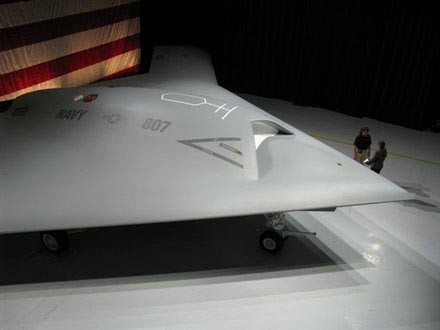The Invisibles against US missile defense
Unleash the Nuclear-Armed Robo-Bombers: Air Force Researcher
7.6.2009 - By Nathan Hodge

President Barack Obama may be beating a path toward nuclear disarmament. But that doesn’t mean a strategist can’t dream of new and better ways to maintain a nuclear deterrent.
Adam Lowther, a research professor at the Air Force Research Institute at Maxwell Air Force Base, Ala., argues in the new issue of Armed Forces Journal that the Air Force should consider replacing its strategic bombers with a nuclear-armed drone, called the nuclear-dedicated unmanned combat aerial vehicle, or ND-UCAV. The ND-UCAV Lowther writes, could be based on the Navy’s X-47B (pictured), a carrier-capable drone that the Navy began funding a few years ago.

“The Air Force could take advantage of the more than $800 million previously invested in the Joint Unmanned Combat Air Systems (J-UCAS) program and the $635 million currently dedicated to X-47B development and rapidly develop a ND-UCAV capable of penetrating defended air space with a small nuclear weapons payload,” Lowther writes.
Before looking closer at Lowther’s arguments, a little context is needed here. Obama’s vision of nuclear abolition faces resistance from the Pentagon, where powerful figures like Secretary of Defense Robert Gates, Chairman of the Joint Chiefs of Staff Adm. Mike Mullen and U.S. Strategic Command chief Gen. Kevin Chilton all support modernization of the U.S. nuclear deterrent. Lowther recently made waves within the nuclear strategy community with “Learning to Love the Bomb,” a Boston Globe op-ed that succintly laid out the views of the “modernizer” camp.
So how would the ND-UCAV work? And would it be a feasible replacement for the aging B-52s and the scarce and expensive B-2 Spirit stealth bombers? (The fleet of nuclear-capable B-1 Lancers is now entirely devoted to conventional missions, i.e., dropping bombs over Afghanistan and Iraq.) Lowther ackowledges there would be serious roadblocks to putting a thermonuclear payload on an unmanned aircraft — most importantly, the argument that keeping a “man in the loop” is essential to the nuclear mission. But he says going unmanned would present an affordable option: an ND-UCAV, he argues, could cost around $150 million per aircraft.
The ND-UCAV idea also looks like a clever way to revive the Air Force’s dreams of a next-generation long-range bomber. As part of a review of the defense budget, Gates canceled a new stealth bomber that was originally scheduled to enter service in 2018. The Air Force, however, is still asking for money to continue the program in some form, and is seeking money to experiment with refueling an unmanned prototype of the new bomber aircraft in flight. An ND-UCAV could fit neatly with the Air Force’s “concept refinement” for the future long-range strike mission.
[PHOTO: Guy Norris/ARES]
www.wired.com
----
NO WEAPONS IN or WAR FROM SPACE.
Please support:
http://Space4Peace.org
Adam Lowther, a research professor at the Air Force Research Institute at Maxwell Air Force Base, Ala., argues in the new issue of Armed Forces Journal that the Air Force should consider replacing its strategic bombers with a nuclear-armed drone, called the nuclear-dedicated unmanned combat aerial vehicle, or ND-UCAV. The ND-UCAV Lowther writes, could be based on the Navy’s X-47B (pictured), a carrier-capable drone that the Navy began funding a few years ago.

“The Air Force could take advantage of the more than $800 million previously invested in the Joint Unmanned Combat Air Systems (J-UCAS) program and the $635 million currently dedicated to X-47B development and rapidly develop a ND-UCAV capable of penetrating defended air space with a small nuclear weapons payload,” Lowther writes.
Before looking closer at Lowther’s arguments, a little context is needed here. Obama’s vision of nuclear abolition faces resistance from the Pentagon, where powerful figures like Secretary of Defense Robert Gates, Chairman of the Joint Chiefs of Staff Adm. Mike Mullen and U.S. Strategic Command chief Gen. Kevin Chilton all support modernization of the U.S. nuclear deterrent. Lowther recently made waves within the nuclear strategy community with “Learning to Love the Bomb,” a Boston Globe op-ed that succintly laid out the views of the “modernizer” camp.
So how would the ND-UCAV work? And would it be a feasible replacement for the aging B-52s and the scarce and expensive B-2 Spirit stealth bombers? (The fleet of nuclear-capable B-1 Lancers is now entirely devoted to conventional missions, i.e., dropping bombs over Afghanistan and Iraq.) Lowther ackowledges there would be serious roadblocks to putting a thermonuclear payload on an unmanned aircraft — most importantly, the argument that keeping a “man in the loop” is essential to the nuclear mission. But he says going unmanned would present an affordable option: an ND-UCAV, he argues, could cost around $150 million per aircraft.
The ND-UCAV idea also looks like a clever way to revive the Air Force’s dreams of a next-generation long-range bomber. As part of a review of the defense budget, Gates canceled a new stealth bomber that was originally scheduled to enter service in 2018. The Air Force, however, is still asking for money to continue the program in some form, and is seeking money to experiment with refueling an unmanned prototype of the new bomber aircraft in flight. An ND-UCAV could fit neatly with the Air Force’s “concept refinement” for the future long-range strike mission.
[PHOTO: Guy Norris/ARES]
www.wired.com
----
NO WEAPONS IN or WAR FROM SPACE.
Please support:
http://Space4Peace.org
« back









